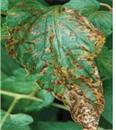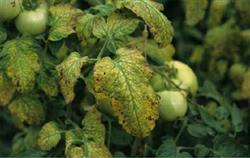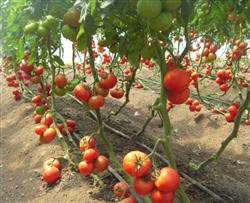Chemical Control of Tomato spot Blight

★ symptoms: tomato spot blight, also known as white star disease. Tomato can occur at all growth stages, infecting leaves, petioles, stems, calyx and fruits. When the leaf is infected, there are water-stained small round spots on the back of the leaf at first, and then dark brown edges on both sides of the leaf, gray-white round or subround slightly sunken in the center, with a diameter of 1.5ml 4.5 mm, and a small number of small black spots scattered on the face. and then the small spots converge into large withered spots, and sometimes the diseased tissue falls off and causes perforation. In severe cases, all the middle and lower leaves dried up, leaving only a few healthy leaves at the top, and the disease spots on stems and fruits were nearly round or oval. Slightly sunken, brown, with black dots scattered on it. The pathogen of ★: Septoria lycopersici SPeg. It is called Cercospora of tomato shell, which belongs to the subphylum fungus of semiknowns. The conidium was spherical or oblate, black, initially buried under the host epidermis, and the latter part broke through the epidermis and was exposed in a small black dot. The shell wall is loose. Part of the mycelium is often adhered to outside the wall, which is 122.5 × 128.6 microns in size, and the outer wall of the orifice is thin, with a diameter of 7.5 Mel 57.5 microns. The conidia are born at the bottom of the oblate globular organ, with a large number, and escape from the orifice after maturation. a single spore is colorless, needle-like, straight or slightly curved, with 9 septum of 3 Mel, and the size is 45 Mel 90 × 2.3 Mel 2.8 μ m. The transmission route and disease condition of ★: the hyphae and conidia overwintered on the diseased remains, perennial Solanaceae weeds or seeds, and became the source of infection at the beginning of the next year. In general, after the conidium absorbs water, the colloid dissolves and the conidia escape, spread by wind and rain or splashed on the tomato plant by Rain Water, invading from the stomata. Later, conidia were produced in the disease department and conidia were enlarged. The suitable temperature for the development of the pathogen was 22 ℃ and 26 ℃, and the dysplasia was below 12 ℃ and above 27.8 ℃. The conidia 52 ℃ was killed in 10 minutes. High humidity is conducive to the overflow of conidia from the apparatus, and the suitable relative humidity is 92%. If the humidity is not reached, the disease will not occur. If there is a lot of rain, especially if it clears up after rain, the growth of tomatoes is weak and fertilizer is insufficient. The temperature is 20 Mel 25 ℃ and the incubation period is 4 days. The prevention and control methods of ★ were as follows: (1) the seedlings were raised in the sunny beds or plots of non-Solanaceae vegetables in the seedling bed or in two years, and the planting fields were rotated for 3-4 years. (2) leave the seeds from the disease-free plants, soak the seeds in 52 ℃ warm water for 30 minutes, take out to dry and accelerate germination and sow. (3) selecting resistant varieties, such as Puhong 1, Guangqie 4 and Shuzao 3. In addition, wild tomato and P422397 have disease resistance genes, which can be used as breeding parents. (4) High border cultivation, proper close planting, pay attention to field drainage and dehumidification. (5) strengthen field management, rational use of fertilizer, increase the application of phosphorus and potassium fertilizer, spray 4000 times of multi-effect liquid or 1.4% compound sodium nitrate water agent 6000, 000 times, can improve disease resistance; avoid planting too dense, keep the field ventilated and transparent and the ground dry; bury or burn the disease residue deeply after harvest. (6) at the initial stage of the disease, spray 64% poisonous alum wettable powder 400 times, or 58% metalaxyl manganese zinc wettable powder 500 times, 75% chlorothalonil wettable powder 600 times, 50% mixed sulfur suspension or 40% multi-sulfur suspension 500 times, or 27% high fat membrane emulsion 80-100 times, every 10 days or so, continuous prevention and treatment for 2 times or 3 times depending on the disease.
- Prev

Chemical Prevention measures of Tomato spot Wilt virus Disease
After infected with the disease at the seedling stage, the young leaves showed copper curl, there were many black spots on the leaves, the veins on the back of the leaves were purple and green, the stems showed discoloration stripes, the diseased plants grew slowly or dwarfed, deciduous, wilted, atrophied, and the yield decreased. In severe cases, the plant wilted and died directly, this symptom is easily confused with stripe virus. The tomatoes are knot.
- Next

Tomato fertilizer-saving and water-saving technology in warm winter greenhouse
Fertilizer saving: considering the cost saving, input reduction and fertilization efficiency, 10000 kg of chicken manure, 50 kg of urea and 50 kg of ternary compound fertilizer are applied per mu, which is the best amount of fertilizer for fruits and vegetables in winter warm greenhouse in Shandong coastal area. Water saving: drip irrigation is adopted, and the soil relative water content is 80%, which is higher than that of conventional furrow irrigation.
Related
- Where is it suitable to grow horseradish in China? it is expected to see the middle altitude horseradish in Alishan.
- How to prevent tomato virus disease reasonably? (Control methods included)
- Many people like to plant towel gourd on the balcony. What are the main points of this method and management?
- What crops can chili peppers be mixed with?
- Fertilization techniques and matters needing attention in Tomato
- What are the grafting techniques for peach seedlings in spring?
- Harm and control methods of root swelling disease of Chinese cabbage
- What are the pests of sweet potatoes? How to prevent and cure it?
- Symptoms, causes and Control methods of navel Rot in Tomato
- The cause of "Cucumber rotten bibcock" in Farmers' planting Cucumber and its Control Plan

